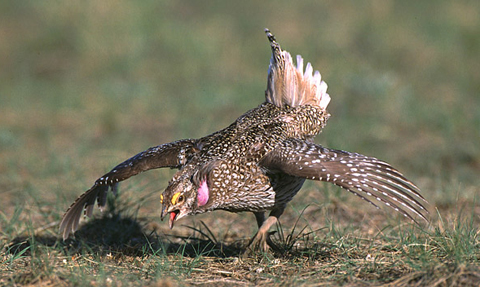“The Grouse or Prarie hen”
Tympanuchus phasianellus: Little Drumming pheasant
© 2003 Brian E. Small / BrianSmallPhoto.com.
A male sharp-tail is dancing to entice his favorite female and intimidate intruding suitors. He fans his tail, rustles and quivers his wings, exposes the yellow stripe to enlarge his eyes, and inflates the pink air sacs to utter his hollow, booming notes.
Practitioners of the natural sciences are said to be of two basic types, lumpers and splitters. Lumpers classify species according to their similarities and make allowances for minute differences, whereas splitters see clarity and truth in closeup views that expose the minutest distinctions. The varied and sometimes contradictory references to this bird—if it was this bird—suggest Meriwether Lewis was a splitter.
Lewis’s Description
The Grouse or Prarie hen is peculiarly the inhabitant of the Grait Plains of Columbia they do not differ from those of the upper portion of the Missouri, the tail of which is pointed or the feathers in it’s center much longer than those on the sides. this Species differs essentially in the construction of this part of their plumage from those of the Illinois[1]Perhaps the prairie chicken, Tympanuchus cupido (cue-pie-do, a comparison with “cupid’s wings” of the little wing-like feathers on its neck, which the male raises over his head in … Continue reading which have their tails composed of f[e]athers of equal length.
in the winter season this bird is booted even to the first joint of it’s toes. the toes are also curiously bordered on their lower edges with narrow hard scale which are placed very close to each other and extend horizontally about 1/8 of an inch on each side of the toes thus adding to the width of the tread which nature seems bountifully to have furnished them at this season for passing over the snow with more ease. in the summer season those scales fall off. They have four toes on each foot.
Their colour is a mixture of dark brown redish and yellowish brown and white confusedly mixed in which the redish brown prevails most on the upper parts of the body wings and tail and the white underneath the belley and lower parts of the breast and tail.
they associate in large flocks in autumn & winter and are frequently found in flocks of from five to six even in summer. They feed on grass, insects, the leaves of various shrubs in the plains and on the seeds of several species of spelts[2]Possibly bluebunch wheatgrass. Spelt is a European species of domestic wheat; Nicholas Biddle spelled it speth. and wild rye which grow in the richer parts of the plains. in winter their food is the buds of the willow & Cottonwoods also the most of the native berries furnish them with food.—
Coues, Terres, et al.
Elliott Coues (pronounced cowz), whose scientific interest centered on ornithology, in 1893 declared Lewis’s “Grouse or Prarie hen” to be the Oregon ruffed grouse, at that time classified as Bonasa umbellus sabinei (Ord) Coues.[3]Elliott Coues, ed., The History of the Lewis and Clark Expedition by Meriwether Lewis and William Clark (1893. Reprint, 3 vols, New York: Dover, 1965), 3:872. He did not use the common name “sharp-tail.” In 1956, John Terres presented the same bird as Pedioecetes phasianellus (ped-ih-ee-see-teez, “plains dweller”; fay-sih-ay-nell-us, “little pheasant”), and noted that its range extends from north-central Alaska through central Canada into Minnesota, Michigan, and west to Idaho and Washington, but no longer includes Oregon.[4]John K. Terres, The Audubon Society Encyclopedia of North American Birds (New York: Wings Books, 1980), 452. The American Ornithological Union’s current (2004) Check-list of North American Birds lists only the ruffed grouse, Tympanuchus (tim-pan-yoo-kus; “drumming”) phasianellus. Gary Moulton concludes (6:378n), “It may be that a definitive answer is not possible and perhaps Lewis became confused in his writing.”
All grouse grow snowshoes during the winter, but Lewis did not observe them on the three grouse he saw along K’useyneiskit—the Road to the Buffalo or the Lolo Trail—possibly because they had not yet developed in September, and had already been shed by the following June.
Notes
| ↑1 | Perhaps the prairie chicken, Tympanuchus cupido (cue-pie-do, a comparison with “cupid’s wings” of the little wing-like feathers on its neck, which the male raises over his head in his mating dance, to expose his fleshy yellowish-pink air sacs.) |
|---|---|
| ↑2 | Possibly bluebunch wheatgrass. Spelt is a European species of domestic wheat; Nicholas Biddle spelled it speth. |
| ↑3 | Elliott Coues, ed., The History of the Lewis and Clark Expedition by Meriwether Lewis and William Clark (1893. Reprint, 3 vols, New York: Dover, 1965), 3:872. |
| ↑4 | John K. Terres, The Audubon Society Encyclopedia of North American Birds (New York: Wings Books, 1980), 452. |
Experience the Lewis and Clark Trail
The Lewis and Clark Trail Experience—our sister site at lewisandclark.travel—connects the world to people and places on the Lewis and Clark Trail.
Discover More
- The Lewis and Clark Expedition: Day by Day by Gary E. Moulton (University of Nebraska Press, 2018). The story in prose, 14 May 1804–23 September 1806.
- The Lewis and Clark Journals: An American Epic of Discovery (abridged) by Gary E. Moulton (University of Nebraska Press, 2003). Selected journal excerpts, 14 May 1804–23 September 1806.
- The Lewis and Clark Journals. by Gary E. Moulton (University of Nebraska Press, 1983–2001). The complete story in 13 volumes.


